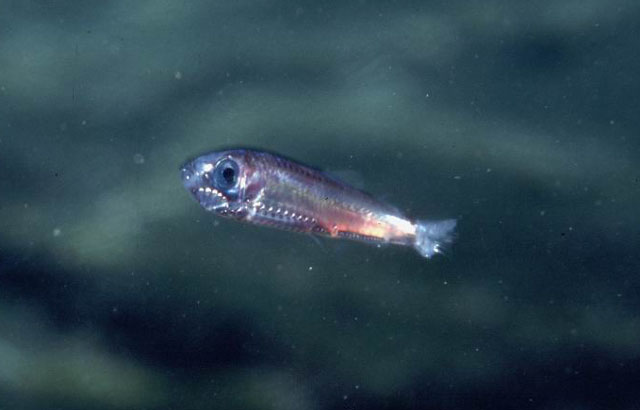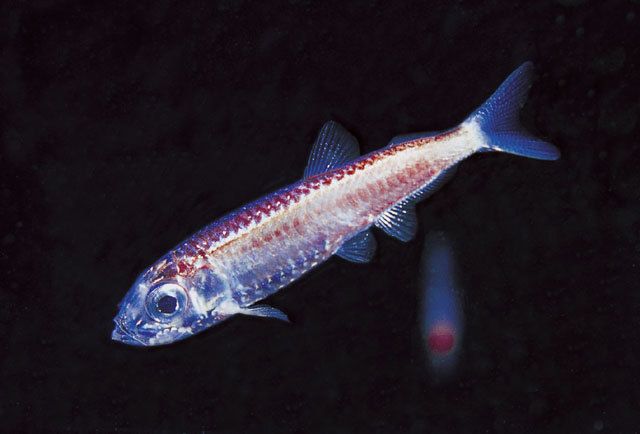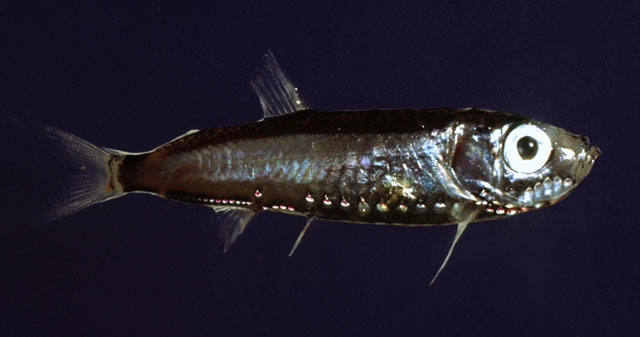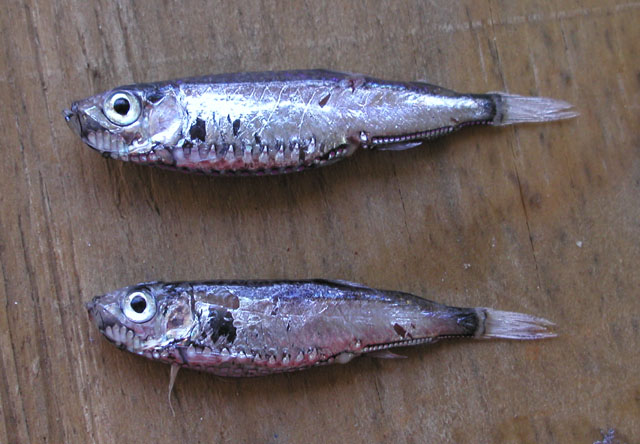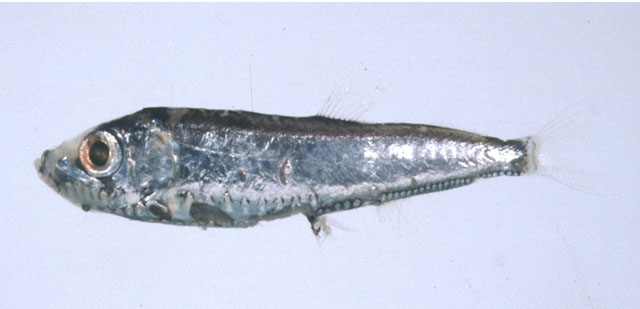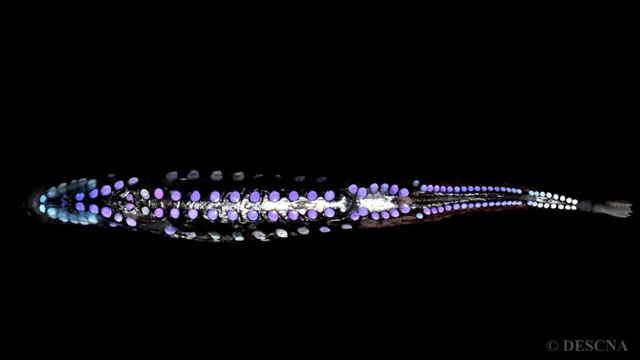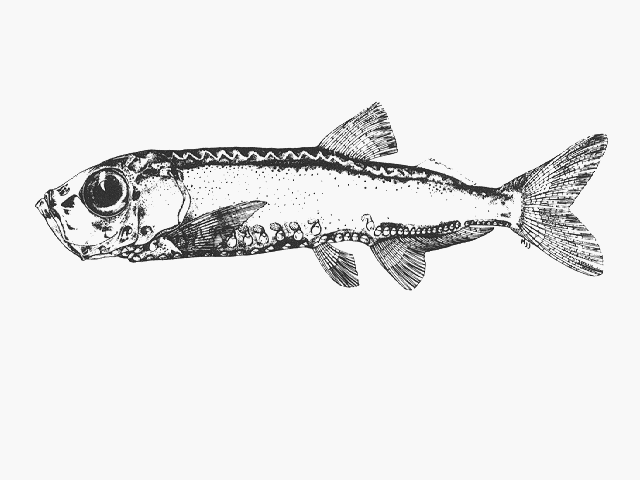Maurolicus
muelleri
(Gmelin,
1789)
Silvery lightfish
View all media / Upload your photos and videos
Expand all
Classification / Names
Teleostei (teleosts) > Stomiiformes (Lightfishes and dragonfishes) >
Sternoptychidae (Marine hatchetfishes)
> Maurolicinae
Etymology: Maurolicus: Greek,mauros, -os, -on = dark + Greek,lykos = wolf (Ref. 45335).
More on author:
Gmelin.
Environment / milieu / depth range / climate zone / distribution range
Distribution
Sub-Arctic, and sub-Antarctic waters of the Pacific and Atlantic oceans and the Mediterranean Sea. Eastern Atlantic:: from Iceland and Norway to Senegal and from Democratic Republic of the Congo to Namibia. In tropical and subtropical waters.
Maps

Maurolicus muelleri / Native range
AquaMaps Data sources:
GBIF
OBIS
This map was computer-generated and has not yet been reviewed.

Maurolicus muelleri / Suitable habitat
AquaMaps Data sources:
GBIF
OBIS
This map was computer-generated and has not yet been reviewed.

Maurolicus muelleri / Point map
AquaMaps Data sources:
GBIF
OBIS
This map was computer-generated and has not yet been reviewed.

Maurolicus muelleri / Year 2050
AquaMaps Data sources:
GBIF
OBIS
This map was computer-generated and has not yet been reviewed.
Size / Weight / Age
Short description
Biology
Oceanic, found to depths of at least 1,524 m. Migrate in the water column at depths of 150-250 m during the day and to about 50 m at night (Ref. 57912, 107678). Mesopelagic (Ref. 5951); abundant near continental shelf-slope breaks and seamounts, rare in the open ocean (Ref. 107678). A cyclic selective feeder of copepods and euphausiids (Ref. 4739). They become sexually mature when 1 year old. Spawning takes place in March - September, producing 200-500 eggs, floating on the surface (Ref. 35388). Lipid content is 5.5 % in fresh body weight and wax ester is 15.3 % in total lipids (Ref. 8966).
Life cycle and mating behavior
Spawns at least twice in in a lifetime (Ref. 57912).
Main reference
Wheeler, A. 1992 A list of the common and scientific names of fishes of the British Isles. J. Fish Biol. 41(suppl.A):1-37. (Ref. 5204)
IUCN Red List Status (Ref. 125652)
Least Concern (LC); date assessed: October 09 2018
CITES (Ref. 131153)
Not Evaluated
CMS (Ref. 116361)
Not Evaluated
Threat to humans
Harmless
Human uses
Fisheries: minor commercial.
FAO - Fisheries: landings, Publication: search | FIRMS - Stock assessments | FishSource | Sea Around Us
More information
- Countries
- FAO areas
- Ecosystems
- Occurrences
- Introductions
- Stocks
- Ecology
- Diet
- Food items
- Food consumption
- Ration
- Common names
- Synonyms
- Metabolism
- Predators
- Ecotoxicology
- Reproduction
- Maturity
- Spawning
- Spawning aggregation
- Fecundity
- Eggs
- Egg development
- Age/Size
- Growth
- Length-weight
- Length-length
- Length-frequencies
- Morphometrics
- Morphology
- Larvae
- Larval dynamics
- Recruitment
- Abundance
- References
- Aquaculture
- Aquaculture profile
- Strains
- Genetics
- Allele frequencies
- Heritability
- Diseases
- Processing
- Mass conversion
- Vision
- Pictures
- Stamps, Coins Misc.
- Sounds
- Ciguatera
- Speed
- Swim. type
- Gill area
- Otoliths
- Brains
Estimates based on models
Preferred temperature (Ref. 123201): 3.2 - 13.3, mean 7.1 °C (based on 301 cells).
Phylogenetic diversity index (Ref. 82804): PD50 = 0.5 [Uniqueness, from 0.5 = low to 2.0 = high].
Bayesian length-weight: a=0.00661 (0.00456 - 0.00957), b=3.23 (3.13 - 3.33), in cm total length, based on LWR estimates for this species (Ref. 93245).
Trophic level (Ref. 69278): 3.0 ±0.0 se; Based on diet studies.
Generation time: 1.2 ( na - na) years. Estimated as median ln(3)/K based on 1 growth studies.
Resilience (Ref. 120179): Medium, minimum population doubling time 1.4 - 4.4 years (K=0.88; Fec=200-500; tm=1).
Fishing vulnerability (Ref. 59153): Low vulnerability (10 of 100).
Climate vulnerability (Ref. 125649): Low vulnerability (23 of 100).
Price category (Ref. 80766): Unknown.
Nutrients (Ref. 124155): Calcium = 111 [41, 279] mg/100g; Iron = 0.673 [0.291, 1.900] mg/100g; Protein = 16.8 [15.2, 18.4] %; Omega3 = 0.2 [0.1, 0.5] g/100g; Selenium = 16.4 [5.1, 46.0] μg/100g; VitaminA = 51.8 [6.4, 402.7] μg/100g; Zinc = 0.988 [0.527, 1.989] mg/100g (wet weight);

